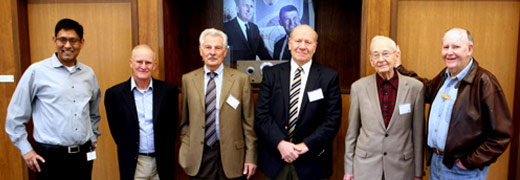HP Labs at 45 – thriving amid HP’s renewed commitment to innovation

From left to right: current HP Labs Director, Prith Banerjee, former Labs directors
Dick Lampman (1999-2007), Frank Carrubba (1987-91), Joel Birnbaum (1984-86 and 1991-99),
Don Hammond (1986-87), and John Doyle (1981-84)
As HP Labs commemorates the 45th anniversary of its founding, HP itself has a renewed commitment to innovation, says Prith Banerjee, Director of HP Labs.
“It’s clear that innovation once again really matters at this company,” noted Banerjee in marking the anniversary. Under the leadership of CEO Meg Whitman, he added, HP is stressing its intention to bring the very best in novel technologies to the global marketplace.
That leaves HP Labs with a clear charge, Banerjee believes. “Our mission is to create absolutely disruptive innovation beyond the current road map of products,” he explained in a recent interview with MIT’s Technology Review.
Disruptive innovation has a long history at the company’s central research arm.
Founded in 1966, HP Labs is the birthplace of the company’s first computer, the HP2116A, the first commercially-available light-emitting diode (LED), the first programmable scientific desktop calculator and thermal inkjet technology.
More recently, HP Labs has pioneered the development of hybrid chip architecture for low-power, high-performance computing, the smart skin patch for painless medication injections, and the Memory Spot wireless data chip. In a major breakthrough for electronics, HP Labs researchers in 2008 first intentionally demonstrated the existence of memristors, the fourth basic element in integrated circuits, that promises to enable a new generation of nonvolatile memory and storage solutions.
“A startup could not invent a technology like the memristor,” Banerjee told Technology Review. “It took us five to 10 years to come up with the right combination of materials and everything else.”
Memristor-based technology is just one of 27 research projects being pursued by teams of researchers at HP Labs’ seven locations around the world. Each is focused on developing technologies with the potential to fundamentally shift current markets and create new commercial opportunities for HP.
After completing a number of major acquisitions in the last few years, HP needs to focus more on internal innovation, CEO Meg Whitman told CNBC last month. Whitman cited as an example Project Moonshot, a recently-announced, HP Labs-designed server architecture based on mobile technology.
“That is much more energy efficient, takes up less space, and could be a game changer in the server business,” Whitman said. “That’s what HP’s known for, and we’ve got to do more of that.”
To further that aim, Banerjee now reports to Whitman directly. That will help him offer “a completely unvarnished opinion of where the technology is headed,” Banerjee believes.
“We also now work directly with the top heads of the business units,” he adds, “so we can help influence the technology vision of the company more.”
Driving innovation is a strategic priority for the entire company in 2012, notes Banerjee – another indicator of HP’s renewed commitment to developing and bringing to market world-changing products, he suggests.
“And after 45 years successfully dedicated to the pursuit of innovation every single day,” Banerjee says, “everyone at HP Labs is excited to help lead that charge."